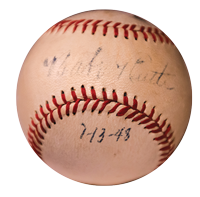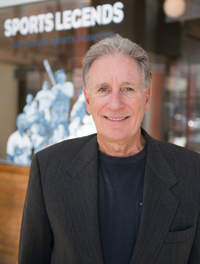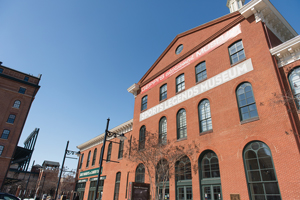Build a Major League Sports Museum
Mike Gibbons ’75, English was making a film about baseball in 1981 when a research expedition led him to Baltimore’s Babe Ruth Birthplace Museum. He liked the place so much that he stuck around – first as a volunteer, then rising to become the institution’s executive director.
Thirty-two years later, Gibbons’ vision now spreads over two downtown sites. Visitors to the Babe Ruth Birthplace can still stand in the very room where the Bambino was born. But since the creation of The Sports Legends Museum and Maryland Sports Hall at nearby Camden Yards in 2005, visitors are charmed by an institution where champion duckpin bowlers and collegiate lacrosse stars are celebrated along with the greatest players from the region’s professional sports teams.
So how did Gibbons transform a small, semi-obscure birthplace attraction into a major league museum destination?
Step 1: SCORE DONATIONS OF COVETED SPORTS MEMORABILIA
The current superheated market for sports memorabilia makes it difficult for museums to purchase items for their collections. So how do you persuade the owner of a valuable Brooks Robinson-autographed baseball to give it the museum instead?
It’s all about relationships, says Gibbons.
The museum has strong ties with the Orioles, Ravens, Baltimore Blast soccer team, and every other regional sports organization, professional and collegiate, so items such as a signed Ray Lewis jersey or Cal Ripken’s cleats come courtesy of the clubs. Families of locally-based sports legends like Johnny Unitas also tend to remember the collection generously when settling an estate.
But Gibbons also delights in the donation of obscure items, which he says come by “constantly connecting and reconnecting” with people. Case in point: The original lyrics to “Thank God I’m a Country Boy” – scrawled in pencil on a torn-out sheet of notebook paper – came to the museum through Gibbons’ relationship with the song’s writer, John Martin Sommers. The 1970s country hit is, of course, the long-standing soundtrack to every seventh inning stretch at a Baltimore Orioles’ game since God was in short pants. John Denver made the song famous, but Sommers actually penned the song when he was the musician and actor’s fiddle player.
Step 2: CHOOSE YOUR ARTIFACTS CAREFULLY
Since there are many more artifacts than the museum has the capacity to store and display, Gibbons says a grateful “no thank you” to many proffered donations. The trick, he explains, is to gauge an item’s outright historical significance against its ability to evoke “emotional experiences” for visitors.
“We are looking for things that specifically tell the story of real deal Baltimore sports,” says Gibbons. So a jersey signed by Cal Ripken (there are plenty of those in existence, it turns out) may not be as valuable to the museum as a worthless-looking hunk of wood currently in storage that happens to be the bench from the 1959 Baltimore Colts victory over the New York Giants in the NFL Championship game at Memorial Stadium.
The heart of the museum is a vault where temperature, light and humidity are minutely calibrated for ideal preservation conditions. Exactly three people have access to this room, all the better to ensure the safekeeping of $10 million worth of items that are either fragile or just small and easily pocketed.
Step 3: MAKE YOUR MUSEUM A LOCAL AND NATIONAL DESTINATION
“Baltimore has such an incredible sports history,” says Gibbons. “The museum sort of sells itself just by existing.” Its location near the city’s two major sports stadiums also ensures significant foot traffic on game days. However, as curator and director, Gibbons has put in a great deal of effort to making the museum’s draw both broad and deep.
Beyond the sure-fire bling of Super Bowl championship rings and World Series trophies, there’s also a gallery featuring the sports triumphs of local college and prep school teams, including the UMBC Retrievers. The official Maryland Sports Hall of Fame, housed on the museum’s lower level, celebrates the achievements of the state’s native-born athletes and all-stars.
Among the museum’s most popular features is an interactive exhibit where young athletes can put on authentic uniforms for Orioles baseball, Ravens football, and Maryland Terrapins basketball teams, try out equipment, even take a swing in the Orioles’ 2004 on-deck batting circle. “Schools come for field trips, kids get a taste and drag their parents back for more later,” he explains.
Gibbons says his approach comes down to something he learned from his writing instructors at UMBC during his undergraduate years: We are all storytellers.
“At the end of the day, a collection of objects is only that – people look once and then keep walking,” explains Gibbons. “But when you use those objects as part of exploring a greater story, that is where fascination begins.”
– Michelle Gienow
By the Numbers
Number of visitors to museum each year: 60,000
Size of museum collection in 2015: More than 10,000 items
Value of Babe Ruth Birthplace and Sports Legends Museum collections: $10 million
Number of audio-visual presentations in museum: 64 (all of them scripted by Gibbons)
Tags: spring 2015




